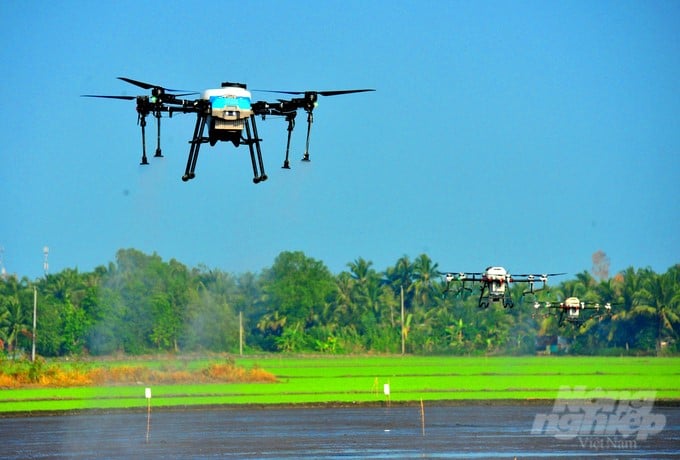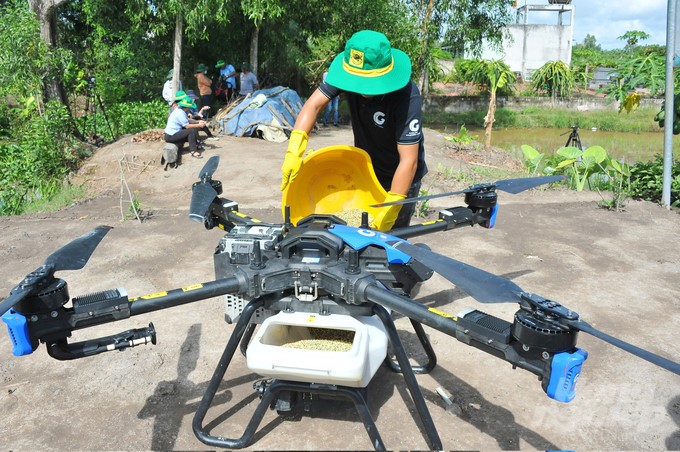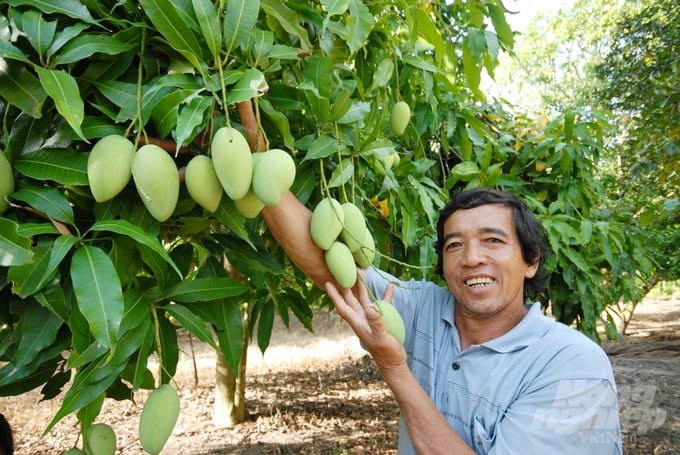May 16, 2025 | 09:47 GMT +7
May 16, 2025 | 09:47 GMT +7
Hotline: 0913.378.918
May 16, 2025 | 09:47 GMT +7
Hotline: 0913.378.918

Digital transformation does not simply apply technology to agriculture but also requires changes in thinking, management methods, and production organization. Photo: Le Hoang Vu.
In the context of globalization and increasing competition, An Giang's agricultural sector must innovate to adapt and develop. Applying digital transformation is the key to achieving this goal, contributing to creating smart, sustainable, and effective agriculture.
According to Mr. Ton That Thinh, Deputy Director of the An Giang Department of Agriculture and Rural Development, the province has more than 80% of agricultural land area (equivalent to 297,000 hectares), and over 65% of the population are rural workers. Farmers have a lot of experience from farming practices and boldly apply technical advances to production. This is the locality's agricultural strength.
Mr. Thinh said that digital technology is currently developing strongly, especially in the agricultural sector. Digital transformation is not only an inevitable trend but also an urgent requirement to improve productivity, quality, and efficiency. Particularly, applying new technologies such as artificial intelligence (AI), the Internet of Things (IoT), Big Data, and Blockchain helps optimize production processes, improve product quality, reduce costs, open up market connection opportunities, enhance product value, and protect the environment.
Specifically, the application of smart irrigation technology combined with fertilization has helped reduce the amount of fertilizer and pesticides and reduce labor costs. This model is applied by many cooperatives, mainly in large growing areas, to save labor. Applying a number of digital platforms and software to record agricultural logs, crop production logs, and traceability of agricultural products gradually builds a clean agricultural model "from farm to table." Growing area codes in agricultural production are an important factor to help manage, monitor, and control the quality of agricultural products, especially in export. The entire province has issued 514 codes with a total growing area of nearly 18,000 hectares.

According to the Department of Agriculture and Rural Development, the entire An Giang province has applied 265 drones to rice sowing, fertilizing, spraying pesticides, and serving over 40% of the agricultural production area. Photo: Le Hoang Vu.
Mr. Nguyen Minh Hien, Chairman of the Board of Directors and Director of Cu Lao Gieng GAP Cooperative (Cho Moi district), said that electronic logs help farmers record the entire production process from care and fertilization to harvest in detail and accurately. Instead of manual logging, using software on smartphones makes management easier and helps information to be stored scientifically, without worry of being lost. Thanks to good management of the production process, gardeners can accurately control the amount of fertilizer and pesticides used, ensuring products meet safety and high-quality standards. Cu Lao Gieng GAP Cooperative has 35 members applying electronic logs in 200 ha of production and applying drip irrigation on an area of 5 hectares to save water in production and plant nutrition.
According to the Department of Agriculture and Rural Development, the entire An Giang province has applied 265 drones to rice sowing, fertilizing, spraying plant protection chemicals, and serving over 40% of the agricultural production area. Thereby, helping to reduce the amount of rice seeds sown from 120-150 kg/ha to 80-100 kg/ha. Seafood enterprises are applying many new technologies in production and business. Typically, Viet Uc Pangasius Joint Stock Company meets the conditions for facilities and technical infrastructure for digital transformation through automatic measurement, a completely automatic sample collection equipment system, an automatic pond environmental monitoring system, and electronic fish identification chips. From there, bring practical economic efficiency, limit diseases, reduce costs, increase productivity, implement traceability data well, and meet export needs.

Currently, the entire province has issued 514 codes with a total growing area of nearly 18,000 hectares. Photo: Le Hoang Vu.
Mr. Ton That Thinh added that digital transformation does not simply apply technology to agriculture but also requires changes in thinking, management methods, and production organization. In order for digital transformation applications to be truly effective, there needs to be close coordination between state agencies, scientists, businesses, and farmers. We need to further promote human resource training, build information technology infrastructure, strengthen support policies from the State, and create strong motivation to continue to act to bring the agricultural sector further and further.
The application of database software for aquatic breeds, aquatic feed, aquaculture environmental treatment products, food safety and hygiene, farming area codes, farming area location, etc., helps specialized management agencies control the businesses' implementation of product information disclosure. At the same time, grasp the production situation of the business, helping customers easily access product information and find out whether the product is still allowed to circulate on the market or not.
Translated by Thu Huyen

(VAN) Cold-barn systems efficiently manage environmental and temperature conditions, which aids in the prevention of respiratory diseases in pigs and protects them from the vectors that transmit African swine fevers.

(VAN) To tackle challenges, the project 'Addressing key technical bottlenecks in the grouper supply chain in Vietnam' has been underway since 2024.

(VAN) The project 'Disease-Resilient and Sustainable Cassava Production Systems in the Mekong Region', funded by the Australian Center for International Agricultural Research (ACIAR), is being implemented from 2024 to 2028.

(VAN) Data from 10,000 farming households will help professionalize production organization and support the implementation of the One Million Hectares Program for High-Quality, Low-Emission Rice Cultivation.

(VAN) FAO Director-General QU Dongyu marks International Day of Plant Health at NENA conference.

(VAN) Deputy Minister of Agriculture and Environment Hoang Trung affirmed that floriculture and ornamental plants are a growing industry that receives significant global attention.

(VAN) The three staple crops dominating modern diets – corn, rice and wheat – are familiar to Americans. However, fourth place is held by a dark horse: cassava.